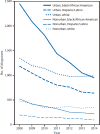Challenges Facing a Rural Opioid Epidemic: Treatment and Prevention of HIV and Hepatitis C
- PMID: 29796965
- PMCID: PMC6085134
- DOI: 10.1007/s11904-018-0393-0
Challenges Facing a Rural Opioid Epidemic: Treatment and Prevention of HIV and Hepatitis C
Abstract
Purpose of review: This article reviews recent epidemiologic trends in HIV and hepatitis C virus (HCV) and strategies for treatment and prevention of these infections as they relate to the opioid epidemic.
Recent findings: Among people who inject drugs (PWID) in the United States (US), HIV diagnoses are decreasing, while HCV is increasing. Care for HIV and HCV relies heavily on specialist infrastructure, which is lacking in rural areas. Antiretrovirals for HIV and direct-acting antivirals for HCV are effective among PWID, yet multiple barriers make it difficult for rural injectors to access these treatments. Similarly, access to syringe service programs, medication-assisted therapy for opioid addiction, and pre-exposure prophylaxis for HIV are all limited in rural areas. Previous research on HIV and HCV among PWID has focused on urban or international populations, yet the US opioid epidemic is moving away from metropolitan centers. Increasing rurality of opioid injection brings unique challenges in treatment and prevention. Research into the care of HIV, HCV, and opioid use disorder among rural populations is urgently needed.
Keywords: HIV; Hepatitis C; Opiate-related disorders; Rural health; Substance abuse, intravenous.
Figures


References
-
- Peters PJ, Pontones P, Hoover KW, et al. HIV Infection Linked to Injection Use of Oxymorphone in Indiana, 2014–2015. N Engl J Med. 2016;375:229–39. - PubMed
-
- Kolodny A, Courtwright DT, Hwang CS, et al. The Prescription Opioid and Heroin Crisis: A Public Health Approach to an Epidemic of Addiction. Annu Rev Public Health. 2015;36:559–74. - PubMed
Publication types
MeSH terms
Substances
Grants and funding
LinkOut - more resources
Full Text Sources
Other Literature Sources
Medical
Research Materials

